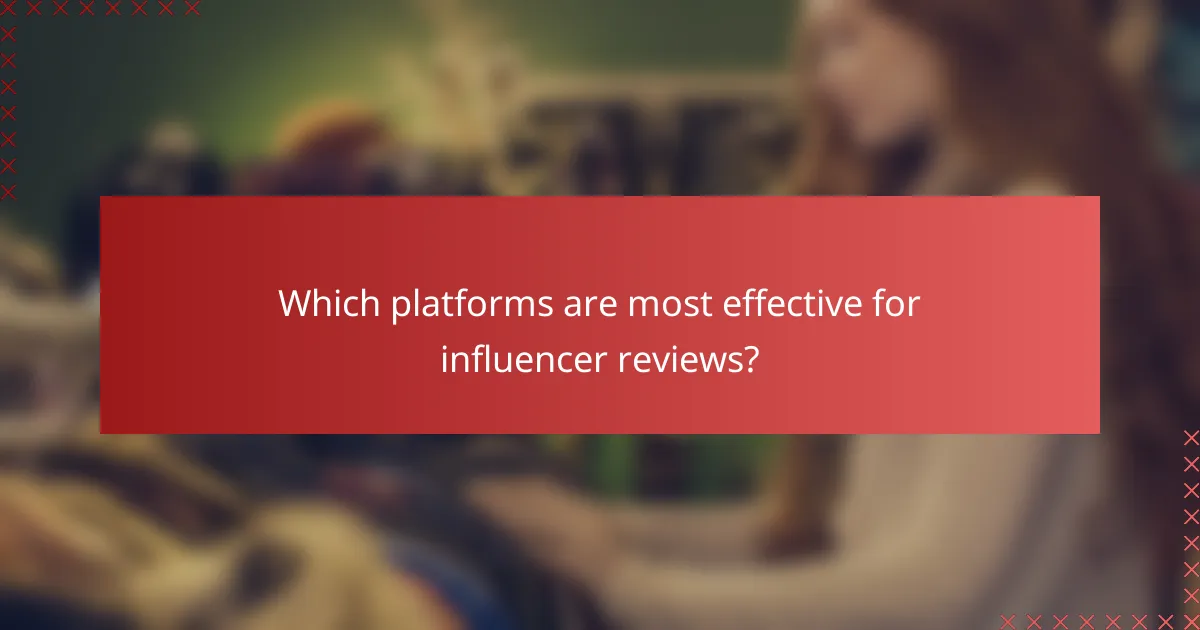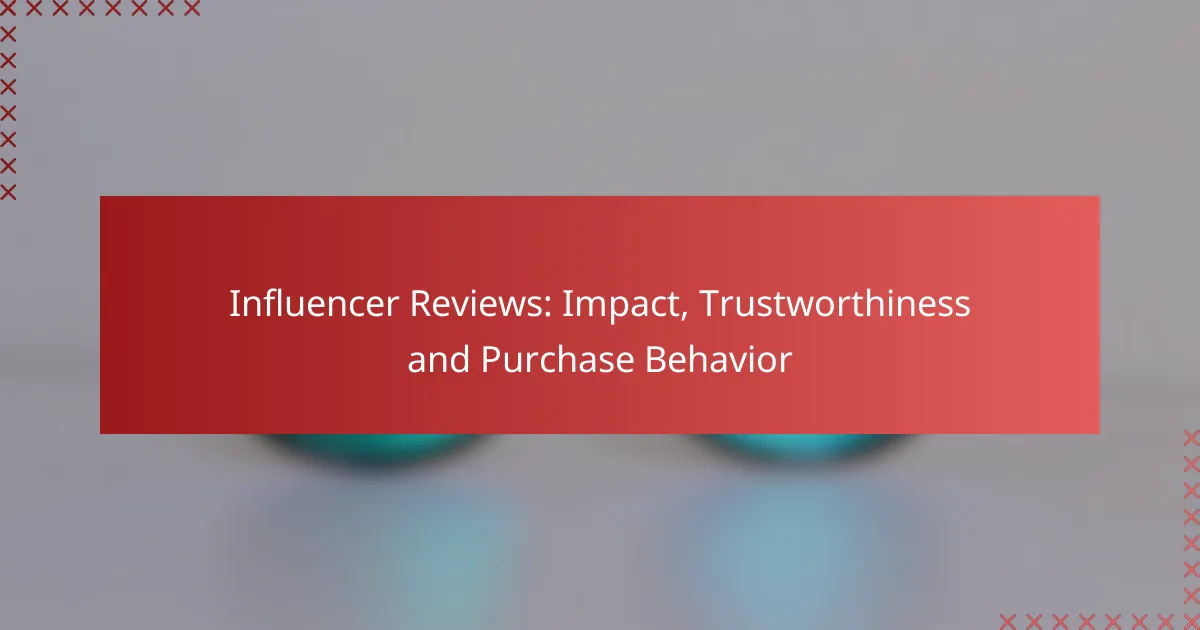Influencer reviews play a crucial role in shaping consumer purchase behavior by fostering trust and offering relatable recommendations. These endorsements are particularly impactful among younger audiences, driving engagement and influencing buying decisions. The perceived trustworthiness of these reviews hinges on factors such as follower engagement, content quality, and brand collaborations, which help consumers gauge the authenticity of an influencer’s opinion.

How do influencer reviews impact consumer purchase behavior?
Influencer reviews significantly shape consumer purchase behavior by enhancing trust and providing relatable recommendations. These endorsements often lead to increased engagement and can drive purchasing decisions, particularly among younger demographics.
Increased trust and credibility
Influencer reviews foster trust and credibility by presenting authentic experiences that resonate with audiences. When consumers see influencers they admire using a product, it creates a sense of reliability that traditional advertising often lacks.
This trust is further amplified when influencers share personal stories or demonstrate the product in real-life scenarios. As a result, consumers are more likely to believe in the product’s effectiveness and consider making a purchase.
Higher conversion rates
Influencer reviews can lead to higher conversion rates, often exceeding those of standard marketing strategies. When influencers promote products, their followers are typically more inclined to act, translating into increased sales.
For example, brands that collaborate with influencers may see conversion rates rise by 5-10% compared to traditional advertising methods. This effectiveness is particularly pronounced in sectors like beauty, fashion, and technology, where visual appeal plays a crucial role.
Influencer authenticity
Authenticity is key to the effectiveness of influencer reviews. Influencers who maintain a genuine connection with their audience tend to have a more significant impact on purchasing decisions. Their followers trust their opinions, which can lead to a stronger influence on consumer behavior.
Brands should seek to partner with influencers who align with their values and target audience. This alignment enhances the perceived authenticity of the review, making consumers more likely to trust the recommendation and make a purchase.

What factors determine the trustworthiness of influencer reviews?
The trustworthiness of influencer reviews is influenced by several key factors, including follower engagement metrics, content quality, and brand partnerships. These elements help consumers assess whether an influencer’s opinion is genuine and reliable.
Follower engagement metrics
Follower engagement metrics, such as likes, comments, and shares, provide insight into how actively an influencer interacts with their audience. High engagement rates often indicate that followers value the influencer’s opinions and are more likely to trust their reviews.
When evaluating an influencer, look for engagement rates that are above industry averages, typically around 1-3% for most platforms. A significant number of meaningful interactions can signal authenticity and a strong connection with the audience.
Content quality and transparency
The quality of content and the level of transparency in reviews are crucial for establishing trust. Influencers who create high-quality, well-researched content and openly disclose partnerships or sponsorships tend to be viewed as more credible.
Consider whether the influencer provides detailed information about the products they review, including personal experiences and clear disclaimers about any affiliations. This transparency fosters a sense of honesty that can enhance trustworthiness.
Brand partnerships and affiliations
Brand partnerships and affiliations can significantly impact the perceived trustworthiness of influencer reviews. Influencers who frequently collaborate with specific brands may be seen as biased, especially if they do not disclose these relationships.
To gauge trust, check if the influencer openly shares their partnerships and how they balance sponsored content with organic reviews. Authentic influencers often maintain a mix of both, ensuring their audience receives unbiased opinions alongside promotional posts.

Which platforms are most effective for influencer reviews?
Instagram, YouTube, and TikTok are among the most effective platforms for influencer reviews, each offering unique strengths that cater to different audience preferences. Choosing the right platform depends on the type of content you want to create and the demographic you aim to reach.
Instagram’s visual appeal
Instagram thrives on visual content, making it ideal for brands that rely on aesthetics. Influencer reviews on this platform often feature high-quality images and engaging stories that showcase products in real-life scenarios.
To maximize impact, brands should collaborate with influencers whose visual style aligns with their own. This ensures authenticity and resonates better with followers, leading to higher engagement and potential purchases.
YouTube’s detailed content
YouTube allows for in-depth reviews, making it suitable for products that require detailed explanations or demonstrations. Influencers can create comprehensive videos that highlight features, benefits, and personal experiences with the product.
Brands should consider partnering with influencers who have a strong following in their niche. A well-crafted video can significantly influence viewer decisions, especially when it includes comparisons or tutorials.
TikTok’s viral potential
TikTok’s short-form video format is designed for quick, engaging content, making it perfect for reaching younger audiences. Influencer reviews on TikTok can go viral, creating buzz around a product in a matter of hours.
To leverage TikTok effectively, brands should focus on trends and challenges that resonate with users. Collaborating with influencers who understand the platform’s dynamics can lead to creative and impactful reviews that drive immediate interest and sales.

How do demographics influence the effectiveness of influencer reviews?
Demographics play a crucial role in how effective influencer reviews are perceived and acted upon by different audiences. Factors such as age, gender, and geographic location significantly shape trust levels and purchasing decisions influenced by these reviews.
Age group preferences
Different age groups respond uniquely to influencer reviews, often influenced by their familiarity with social media and online shopping. Younger consumers, particularly those in their teens and twenties, tend to trust influencers more than traditional advertising, often valuing authenticity and relatability.
In contrast, older demographics may prefer reviews from established figures or experts in a field, as they often seek credibility and experience. Brands should tailor their influencer partnerships based on the target age group to maximize engagement and conversion rates.
Gender-specific influences
Gender can significantly affect how influencer reviews are received. Research indicates that women are more likely to trust and engage with influencers who share personal stories and experiences, particularly in sectors like beauty and fashion.
Men, on the other hand, may prioritize practicality and performance in reviews, especially in categories such as technology and automotive products. Understanding these gender-specific preferences can help brands select the right influencers to resonate with their target audience.
Geographic variations in trust
Geographic location influences the effectiveness of influencer reviews due to cultural differences and varying levels of social media penetration. For instance, consumers in urban areas may have higher trust in influencers compared to those in rural regions, where traditional marketing methods still hold sway.
Additionally, regional trends can affect which influencers are deemed credible. Brands should consider local influencers who understand the cultural context and preferences of their audience to enhance trust and drive sales effectively.

What criteria should brands consider when selecting influencers?
Brands should evaluate several key criteria when selecting influencers, including audience alignment, engagement rates, and content relevance. These factors help ensure that the influencer’s audience matches the brand’s target market, fostering trust and increasing the likelihood of successful campaigns.
Audience alignment
Audience alignment refers to the degree to which an influencer’s followers match the brand’s target demographic. Brands should analyze the influencer’s audience characteristics, such as age, gender, location, and interests, to ensure they resonate with their own customer base. For example, a beauty brand targeting young women may prioritize influencers with a predominantly female audience aged 18-30.
To assess audience alignment effectively, brands can use tools like social media analytics or audience insights provided by platforms. This data helps identify potential gaps or overlaps, allowing brands to make informed decisions about which influencers to collaborate with.
Engagement rates
Engagement rates measure how actively an influencer’s audience interacts with their content, typically expressed as a percentage of likes, comments, and shares relative to total followers. Higher engagement rates often indicate a more invested audience, which can lead to better conversion rates for brands. Generally, engagement rates above 2-3% are considered strong, though this can vary by industry.
Brands should not only look at overall engagement but also consider the quality of interactions. Comments that reflect genuine interest or inquiries about products can signal a more engaged audience. Monitoring trends over time can also provide insights into whether an influencer’s engagement is growing or declining.
Content relevance
Content relevance involves evaluating how well an influencer’s content aligns with the brand’s messaging and values. Brands should consider whether the influencer regularly produces content that reflects their products or services, as this can enhance authenticity and trust. For instance, a fitness brand would benefit from partnering with influencers who consistently share workout tips, nutrition advice, or healthy lifestyle content.
To ensure content relevance, brands can review an influencer’s past posts and collaborations. It’s essential to look for consistency in themes and values, as mismatched content can lead to confusion among consumers and dilute brand messaging. Additionally, brands should consider the influencer’s storytelling style to ensure it complements their own brand narrative.

How can brands measure the impact of influencer reviews?
Brands can measure the impact of influencer reviews by analyzing key performance indicators such as engagement rates, sales conversions, and brand sentiment. These metrics provide insights into how effectively influencer content drives consumer behavior and influences purchasing decisions.
Tracking sales conversions
Tracking sales conversions is essential for brands to understand the direct financial impact of influencer reviews. This can be done by using unique discount codes or affiliate links that influencers share with their audience, allowing brands to attribute sales directly to specific reviews.
Brands should monitor conversion rates over time to assess the effectiveness of different influencers and campaigns. A good benchmark is to aim for conversion rates between 1-5%, depending on the industry and the influencer’s reach.
To optimize tracking, brands can use analytics tools that integrate with e-commerce platforms, providing real-time data on sales generated from influencer promotions. Regularly reviewing these metrics helps brands refine their influencer strategies and improve ROI.
